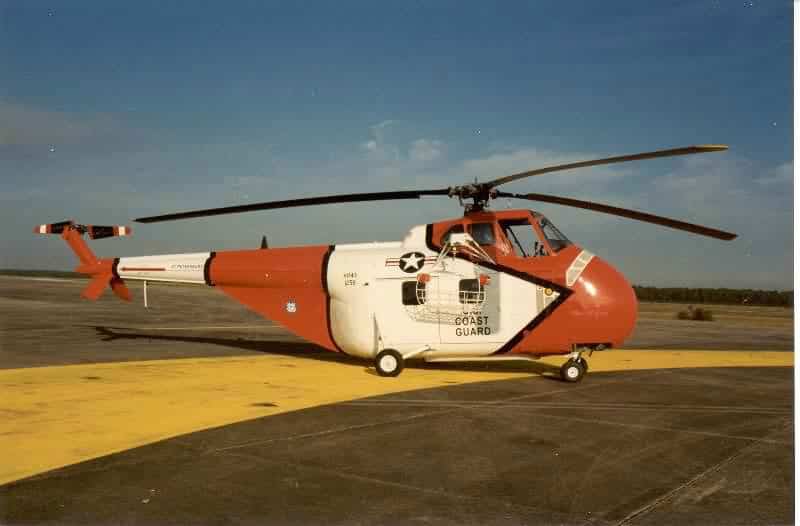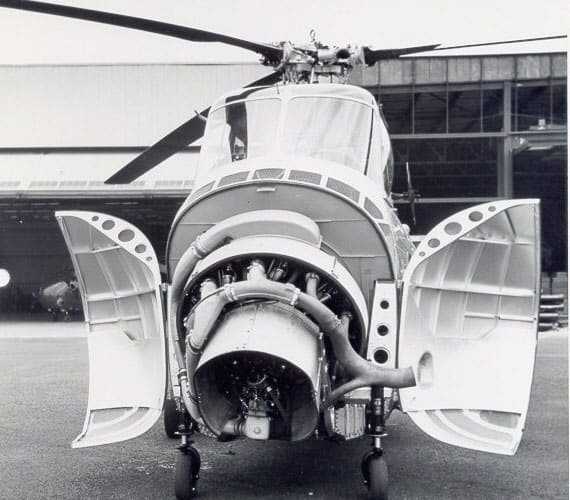
Sikorsky Model S-51 (HO3S) had enjoyed both military and commercial acceptance which led Sikorsky to initiate a follow-on design capable of carrying 10 passengers or equivalent cargo. The Sikorsky Model S-55 was built, without government funds, to compete against large tandem-rotor helicopters such as Piasecki’s PD-22 (H21) that did not require fore and aft balancing as did a one rotor helicopter.
The S-55 design placed the engine forward of the center section and relocating the cockpit above it. Not only did this provide direct access to the engine, through outward opening clamshell doors, for maintenance purposes but it eliminated the critical center of gravity problem of the helicopter by placing the cabin compartment directly below the rotor hub. A drive shaft transmitted engine power to the three-bladed main rotor through the center rear section of the cockpit. The fuel tanks were placed under the cabin. The principle drawbacks of a single-rotor design had been overcome.
The subsequent impact of the S-55 was unforeseen at the time of its initial introduction. The Korean conflict was on the horizon and this war demonstrated the abilities of the helicopter and brought it into prominence. The Sikorsky S-55 designated H-19 by the Air Force, HO4S by the Navy and HRS by the Marine Corps, was reliable, versatile, and adaptable to diverse requirements. It was used for troop transport; air rescue; cargo transport both internally and by external sling loading; and for the first time casualties could be carried and attended to under cover within the helicopter.
In November of 1951, the Coast Guard acquired the first of seven HO4S-1s modified for search and rescue purposes. The Modification was designated HO4S-2G. These helicopters were powered by a 550 horsepower Pratt & Whitney R-1340 engines. In January of 1952 the first of 23 HO4S-3G helicopters, powered by the 700hp Wright R-1300 engine, was delivered to the Coast Guard. All were fitted with a rescue hoist and in 1954 the Coast Guard designed rescue basket became standard equipment. An additional eight HRS-3s were obtained from the Navy and modified for Coast Guard use. The HO4S-3G was the first helicopter to be equipped for night operations and instrument flight.
The HO4S helicopters extended the Coast Guard’s rescue capabilities far beyond what was imagined 20 years prior. Although underpowered by today’s standards it was the first operational helicopter capable of carrying multiple survivors in a cabin and carry heavy loads. It had a rescue hoist capable of lifting 400 pounds and could fly at a normal forward speed of 80 knots with a range of 350 nautical miles. It proved, beyond all doubt, the capabilities and value of the helicopter for Coast Guard operations. They performed numerous rescues during the next decade, some best described as miraculous, within parameters never before achieved. The helicopter became the primary asset for the saving of life.
| Manufacturer | Sikorsky Aircraft | Top Speed | 98 kts |
| Designation | HO4S-3G | Cruising Speed | 80 kts |
| Aircraft Type | Rescue Helicopter | Fuel Capacity | 190 gallons |
| Rotor Diameter | 53’ | Range | 350 nm |
| Height | 13’ 4” | Crew | 2 or 3 |
| Length | 42’ 2” | Hover Ceiling | 7900 feet |
| Empty Weight | 5250 | Service Ceiling | 16,000 feet |
| Gross Weight | 7500 | Engine | 700 hp Wright R-1300 |
Operation “Tug-Bird”
During August 1957 Headquarters authorized the Coast Guard Air station St. Petersburg to conduct “Operation Tug-Bird” with a HO4S helicopter to determine the practicability of Towing disabled vessels. The project helicopter successfully towed various craft ranging in size from the Air Station’s 18 footer to the 794 ton buoy tender Juniper. At no times did the tows require more than 3000 pounds line pull under test conditions. Tow speeds averaged 12 knots. Headquarters directed that each air station should have at least one HO4S helicopter permanently equipped for towing. This HO4S had a reinforced tail plate with a stainless steel line attached on the rear of the helicopter by U-bolt equipped with an explosive device. The helicopter could tow a disabled vessel away from the rocks to deep water and lay the tow line over the bow of a Coast Guard cutter or patrol boat. When the vessel’s crew had the line, the explosive bolt was fired and the line dropped on the forecastle.
The following is a narrative of a towing mission of San Francisco HO4S CGNR 1309: A towline was put aboard the 36 foot fishing vessel Pirate II that had lost an engine and was going on the rocks. The helicopter commenced towing in a position less than 50 yards from Seal Rocks. At first it appeared that little progress was being made. The wind at this time was 22 -28 knots and the tow was directly into seas of 10 to 15 feet. With towing tension surging as high as 3100 pounds the helicopter gradually succeeded in towing the Pirate II out of danger to a point one half mile off shore where the tow was turned over to a Coast Guard patrol boat CG-82328. The mission was a complete success.
Complete records as to how many times this procedure was utilized are not available but with the arrival of the HH-52 the procedures and skill level required had deteriorated and the practice was discontinued. The Navy, however. uses the procedures developed by the Coast Guard for towing paravanes to remove mines.


